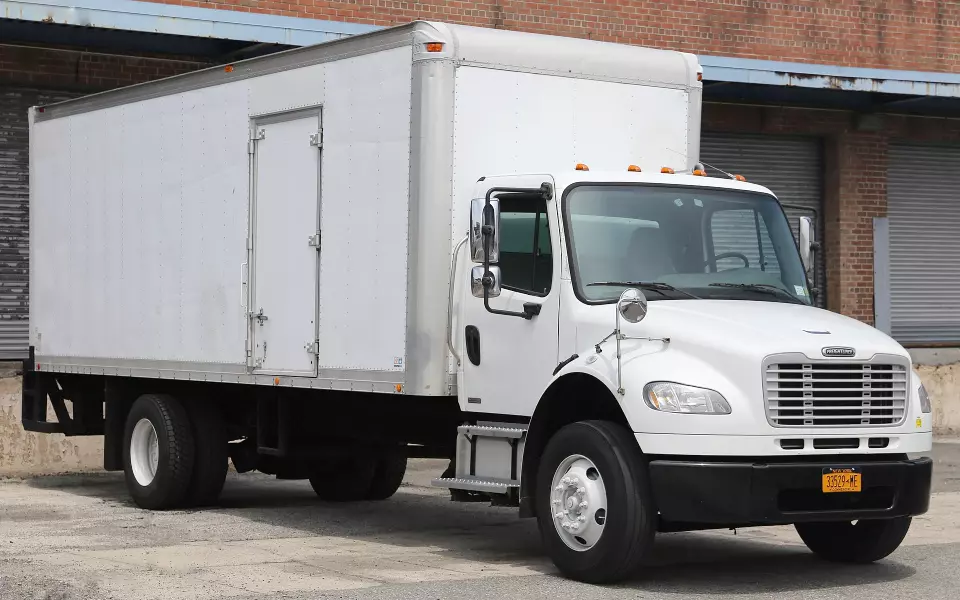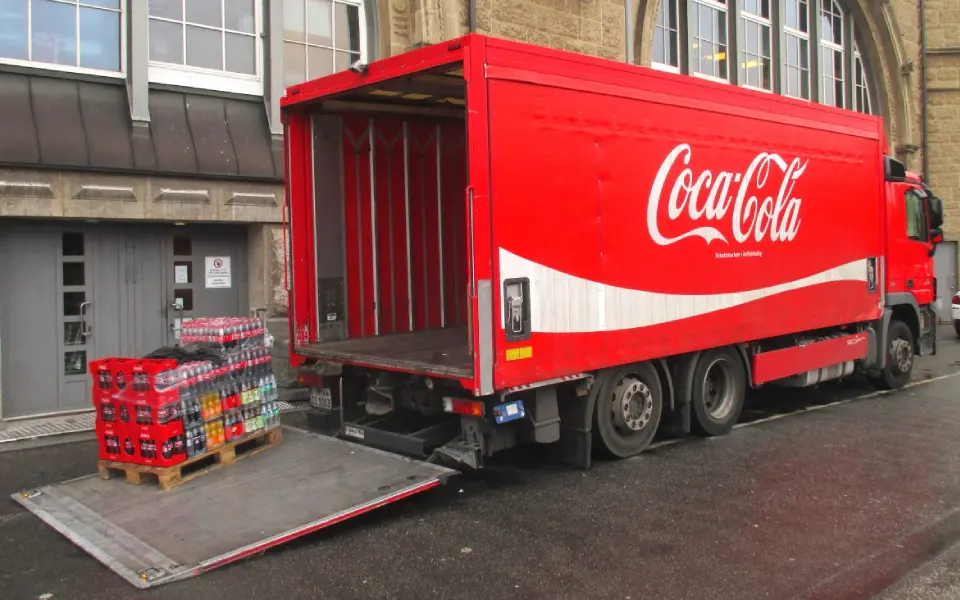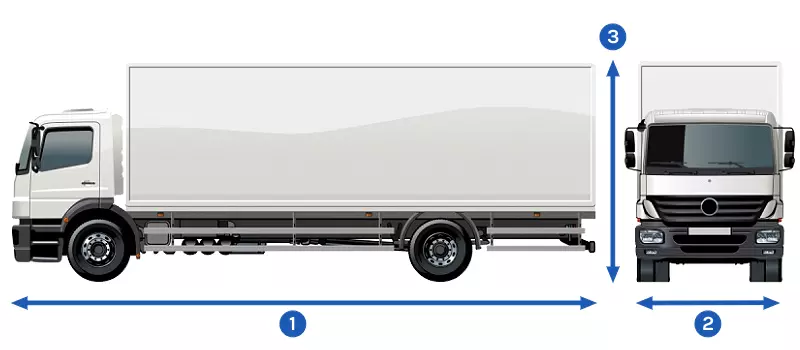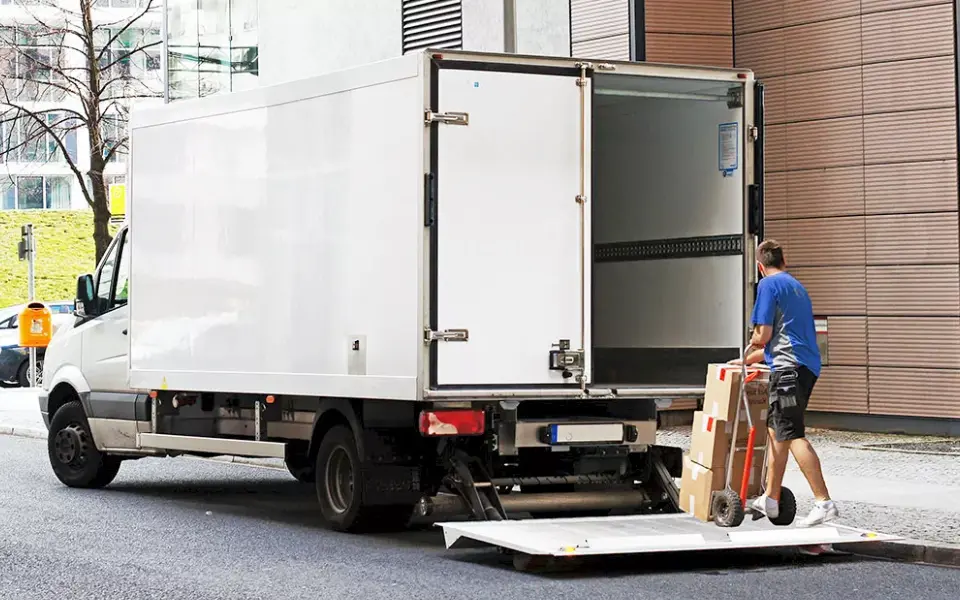According to the American Trucking Association, freight trucks move more than 70% of domestic freight, as it remains the most popular mode of freight transportation. Besides being a cost-effective way to move cargo, it’s also an integral part of intermodal transportation, moving goods to and from seaports, airports, and rail depots.
Generally speaking, trucks move cargo in two ways; through full truckloads (FTL) and less-than-truckloads (LTL). FTL is used to move a single shipment in one load, whereby LTL is used to transport multiple shipments in a single load.
While semi-trucks are typically used to move intermodal containers, specialized cargo on trailers, or FTL loads, box trucks have the flexibility of moving FTL & LTL loads, as they come in various sizes and configurations.
In this article, we’ll dive deeper into box trucks and discuss their specifications, use cases, benefits, and drawbacks, as well as other important details.
Here’s the content that this article will cover:
- Box Tuck Definition
- Suitable Cargo for Box Trucks
- Box Truck Specifications
- Costs of Box Trucks
- Box Truck License Requirements
- Benefits of Box Trucks
- The Drawback of Box Trucks
What Is a Box Truck?
Box trucks, also known as cube trucks or box vans, are medium-sized straight trucks with a cuboid-shaped cargo storage area connected to the cabin by a single chassis or frame.

These characteristics differentiate box trucks from semi-trucks, which are not connected through a single frame (they consist of a semi or cab, and a separate trailer). In addition to that, a box truck does not have the capabilities to haul container loads and can only transport loose cargo, unlike a semi-truck.
Box trucks offer a great degree of versatility, as they have a lower center of gravity, providing more stability while driving, and are typically shorter allowing for better maneuvering. This also means that they have great accessibility, depending on the road network.
As box trucks remain one of the most popular freight vehicles in the trucking industry, it is important for most truck drivers and dispatchers, particularly those new to the industry, to learn about them.
Another important benefit of operating box trucks is that they don’t require a commercial driver’s license, as long as their gross vehicle weight rating is 26,000 pounds or less.
What Type of Cargo Is Suitable For Box Trucks?
Box trucks are among the most versatile freight vehicles due to their open-bed design, option for smaller-sized chassis, and other unique features and specifications.

As a result, they’re commonly used to deliver almost all types of cargo in small or large loads, including:
- Perishable goods – Perishable goods typically include all items that can deteriorate when not kept or transported under appropriate storage conditions. Popular examples include food items like fruits, vegetables, dairy, and meat, as well as chemical materials like natural resins and pharmaceutical products. Box trucks regardless of size can have refrigeration installed for their cargo storage.
- Furniture – Box trucks also transport all types of furniture, including chairs, tables, beds, sofas, dressers, desks, and more. These trucks are either owned directly by the furniture manufacturer or a trucking business that they engage for delivery.
- Personal Effects – Many moving companies utilize box trucks of different sizes and capacities to help people move or relocate to new cities, states, or countries. Items such as clothes, soft furnishings, electrical appliances, cooking and eating utensils, dishes, and more can easily fit in box trucks.
- Machinery & Equipment – While box trucks aren’t designed to move out of gauge machinery or oversized equipment, they are commonly used to move power tools, forklifts, generators, line trimmers, wheelbarrows, and other popular lightweight tools, equipment, and other types of machinery.
- Medicine & Vaccines – These trucks are also among the most popular freight vehicles that supply medicines and vaccines to pharmacies, retail outlets, and customers. This is due to their accessibility and maneuverability throughout the city, as well as the ease of loading and unloading goods.
- Food & Beverages – Trucking accounts for nearly 70% of commercial and non-commercial food and beverage transportation. Moreover, most carriers use box trucks to move small amounts of food items and beverages in cans and other types of packaging. Popular examples include grains, sugar, soft drinks, cereal, and bread.
- Building Material – While they aren’t able to transport large steel pipes or cement structures, box trucks are excellent for moving smaller construction materials. These materials include packaged cement and aggregates, wood, marble, tiles, pipes, and wiring.
- Commodities – Commodities shipped include wheat, seeds of fruits and vegetables, edible oil, pulses, and small (packaged) petroleum products. These are usually transported loose, packaged in drums, or stacked on pallets in larger box trucks for high-volume transportation.
- Apparel & Accessories – Apparel & accessories can include a wide range of products, from shoes to gloves, socks, jackets, shirts, pants, jewelry, watches, sunglasses, and more.
- General Cargo – Finally, many carriers use box trucks to ship general cargo typically packed in pallets, packages, boxes, and barrels. A large amount of general cargo is also loaded loose (typically for smaller deliveries).
As such, box trucks are extremely versatile and can be used to ship any type of cargo except liquids and gases unless they’re stored in smaller, suitable containers.
Box Truck Specifications
As mentioned earlier, box trucks come in different types and sizes. However, they can be easily distinguished based on specifications such as dimensions, weight limits, loading capacities, and curb weight. Let’s explore each of these aspects in more detail below.
Box Truck Dimensions
The size of a box truck is mainly defined by its length, which can be between 10 and 26 feet since they mostly have two axles. However, the exact dimensions vary depending on the make and model of the vehicle.

- Maximum Length for Box Trucks: 40′ – 60′ (state regulated)
- Maximum Width for Box Trucks: 8′ 6″ – 9′ (federal CMV regulation)
- Maximum Height for Box Trucks: 13′ – 15′ (state regulated)
An example of a typical 24-ft box truck (in length) measurements would usually be around 8 ft wide and 8 ft high. In comparison, box trucks with three axles can span over 50 feet in certain states but would typically be regulated to a maximum length of 40-45 feet in most others.
For more detailed dimension regulations, we have included a table in a separate article that you can find here.
Box Truck Weight & Weight Limits
According to the Federal Highway Administration (FHWA), trucks are classified into different group classes ranging from 3 to 13. Box trucks usually fall into categories 3 to 8, meaning they can haul various cargo but would have a weight limit of between 10,001 and 33,001 pounds.
Moreover, box trucks falling in these classes can weigh between 7,650 and 14,500 pounds without cargo but with all standard equipment and a full tank of fuel (curb weight).
Below is a quick summary of each truck class:
| Truck Class | Box Truck Type | Weight Limit (lbs) | Curb Weight (lbs) |
| 3 | Small Walk-In Trucks | 10,001 – 14,000 | 7,650 – 8,750 |
| 4 | Small Delivery Trucks, Walk-In Trucks | 14,001 – 16,000 | 7,650 – 8,750 |
| 5 | Standard Delivery Trucks, Large Walk-In Trucks | 16,001 – 19,500 | 9,500 – 10,000 |
| 6 | Beverage Trucks, Large Delivery Trucks | 19,501 – 26,000 | 11,500 – 14,500 |
| 7 | Heavy-Duty Box Trucks | 26,001 – 33,000 | 11,500 – 14,500 |
| 8 | Heavy-Duty Box Trucks | > 33,000 | > 11,500 |
Box Truck Load Capacity
A box truck’s payload capacity is based on gross vehicle weight ratings (GVWR) set by the Federal Highway Commission, US Census Bureau, and US Department of Energy. The table below shows the maximum load capacity (lbs) of different types of box trucks.
For instance, small walk-in box trucks have a GVWR of 7,250 Lbs, meaning this is the maximum gross weight they can transport safely and legally. Many carriers use these ratings to ensure they don’t overload their box trucks.
| Box Truck Class | Box Truck Type | Maximum Load Capacity (lbs) |
| 4 | Small Walk-In Trucks | 7,250 |
| 5 | Small Delivery Trucks, Walk-In Trucks | 8,700 |
| 6 | Standard Delivery Trucks, Large Walk-In Trucks | 11,500 |
| 7 | Beverage Trucks, Large Delivery Trucks | 18,500 |
| 8 | Heavy-Duty Box Trucks | 54,000 |
Box Truck Costs
A major factor that determines the price range of a box truck is its size and capacity. Light-duty box trucks are the least expensive, followed by medium-duty and heavy-duty trucks. However, truck prices vary according to several other factors, including make, model, condition, mileage, and age.
For example, a one-year-old truck can be bought at a price that’s around 20-30% cheaper than its original value. Similarly, a new small-duty box truck can cost more than a 10-year-old medium or heavy-duty truck.
Therefore, learning about the price ranges of these trucks can help you make a better purchase decision when exploring the market.
| Categories | Vehicle Class | New Vehicle Price (USD) | Used Vehicle Price (USD) |
| Small Box Trucks | 3 | $25,000-$45,000 | $10,000-$75,000 |
| Standard Box Trucks | 4 – 5 | $35,000-$70,000 | $12,500-$83,250 |
| Large Box Trucks | 6 – 8 | $50,000-$120,000 | $9,500-$106,000 |
As you can see from the table, box truck prices vary significantly. Used truck prices are mainly based on mileage and condition. However, they can also sell higher than new trucks due to upgrades or modifications, such as Electronic Logging Devices (ELDs), auxiliary power units (APU), better tires, turbocharger kits, and lift gates, among various other upgrades.
Besides the cost of trucks, carriers and owner-operators have to bear other truck expenses, including insurance, taxes, provisions, and licenses (for heavy-duty box trucks). Due to these costs, many dealers, manufacturers, and even trucking companies offer lease-to-own or financing programs, especially for new drivers with modest budgets or bad credit.
License Requirements for Box Trucks
As mentioned earlier, light-duty box trucks with a Gross Vehicle Weight Rating (GVWR) of 26,000 lbs or less don’t require drivers to have a commercial driver’s license (CDL). However, box trucks with GVWR ratings above 26,001 lbs require a Class A, B, and/or C CDL.
A Class A CDL is a universal license that allows drivers to operate different types of commercial trucks. A Class B CDL is made specifically for straight trucks, box trucks, dump trucks, and a few other freight vehicle classes. Therefore, it’s slightly more limited than a Class A CDL.
Finally, a Class C CDL is required for drivers transporting less than 26,001 lbs gross weight of hazardous materials using box trucks.
Benefits of Box Trucks
Box trucks offer an extensive list of benefits for drivers and carriers, which explains why they’re among the most popular commercial freight vehicles in the market and used for various types of applications.

They’re available in a wide range of sizes and storage capacities, meaning buyers can procure them at different prices based on their budgets and business model. The following are some of the key benefits of a box truck:
- Lower Capital Requirements – Box trucks cost less since they’re smaller than most other commercial trucks, including semi-trucks, tractor-trailers, and 18-wheelers. Moreover, they’re the go-to choice for truck drivers with modest budgets or those new to the industry looking to gain experience before deciding on larger trucks.
- Lower Maintenance Fees – Box trucks are commonly used for short-haul transportation due to their relatively smaller size and payload capacities. As a result, their engines experience relatively less wear and tear daily due to lower mileage. Therefore, they require less frequent maintenance. Moreover, they’re easier to fix than larger trucks, as they feature more commonly available parts. This further reduces the repair and maintenance costs.
- Easily Modifiable – Another excellent benefit box truck offers owners is a wide range of modification options. From simple lift gate installations to all-terrain tires, step bars, cold air intake, and reefer box conversions, there’s much you can do to improve your truck’s performance or integrate new freight applications.
- Flexible Application & Utilization – Box trucks are among the most versatile freight vehicles in the market. They can be used for many cargo-hauling applications, like moving furniture, making perishable food deliveries, and transporting construction materials.
- Wide Range of Sizes & Types – As mentioned previously, box trucks are available in different sizes and types. Smaller ones are generally cheaper and much easier to maneuver, making them excellent for new drivers. Similarly, larger trucks can transport more cargo, enabling carriers and owner-operators to make more money from a single trip.
- Faster Turnaround – Since the cabins and storage compartments of box trucks are connected to a single frame (commonly referred to as chassis), they don’t require coupling or decoupling of trailers like semi trucks do. Therefore, they offer faster loading and unloading times.
- Effective Solution to LTL – Overall, box trucks are the go-to choice for less-than-truckload transportation for several reasons. For starters, they’re cheaper, meaning carriers can procure multiple trucks and improve their fleet cost-efficiency. Moreover, they offer faster loading and unloading times, which can improve delivery timelines and minimize delays. Furthermore, since box trucks have less payload capacity, they transport fewer goods than semi-trucks and other larger freight vehicles. Therefore, reducing the handling time during transit.
Drawbacks of Box Trucks
Like any other freight vehicle, box trucks also have a few prominent drawbacks you should consider before procuring one, such as:
- Single-Frame Truck – From a hauling perspective, the biggest drawback of a box truck is its single frame that doesn’t support coupling. As a result, it can’t be used to haul trailers, so it won’t be able to transport intermodal shipping containers.
- May Require a CDL – Depending on the truck class you opt for, you may require a CDL, as explained earlier. Getting a CDL can be difficult and requires extensive training and practice. While opting for a smaller truck is a viable option to avoid getting a CDL, the tradeoff is smaller payload capacities, which can affect your earnings.
- Requires Labor for Loading and Unloading – Box trucks require more laborious loading and unloading since you have to move cargo in and out of it physically. In contrast, semi-trucks with trailers may be de-coupled and the truck is ready to be coupled to a different trailer for the next haul. Moreover, box trucks usually transport loose cargo which requires longer handling time in loading and unloading.
- Limitations of Cargo Size – Unlike other trucks, you cannot use box trucks for oversized cargo transport due to limited cargo size. Moreover, you can’t use them to ship cargo that exceeds the standard length, width, and height dimensions (out-of-gauge cargo).
- Requires Load Optimizing – Loading a box truck requires more planning and optimization to avoid overloading while ensuring you use all of its capacity for maximum revenue. Moreover, loads should be secured to ensure it doesn’t move during transit.

Get Free Course Access
If you enjoyed the article, don’t miss out on our free supply chain courses that help you stay ahead in your industry.

Andrew Lin
Co-Founder & Writer
at freightcourse
About the Author
Andrew is a multi-business owner with over 12 years of experience in the fields of logistics, trucking, manufacturing, operations, training, and education.
Being the co-founder of freightcourse has given him the ability to pursue his desire to educate others on manufacturing and supply chain topics.
Follow us